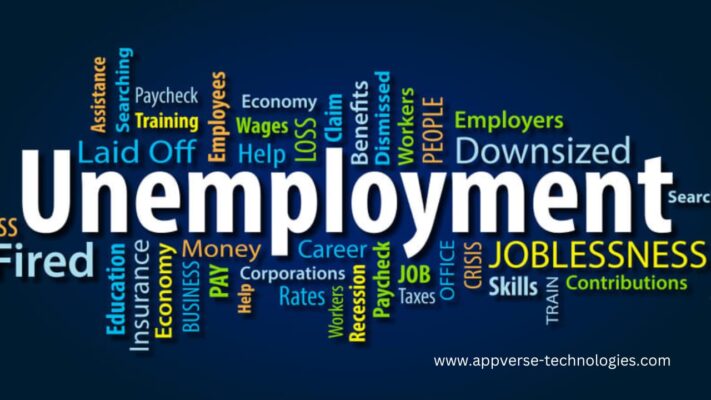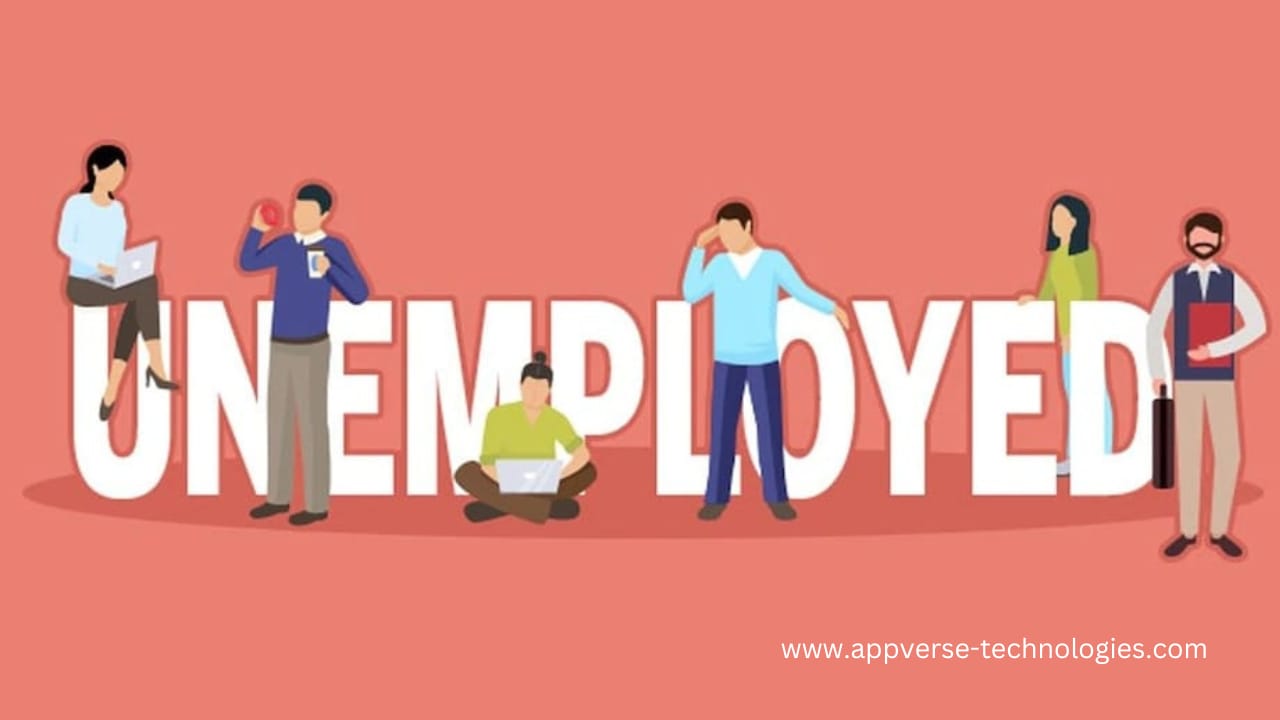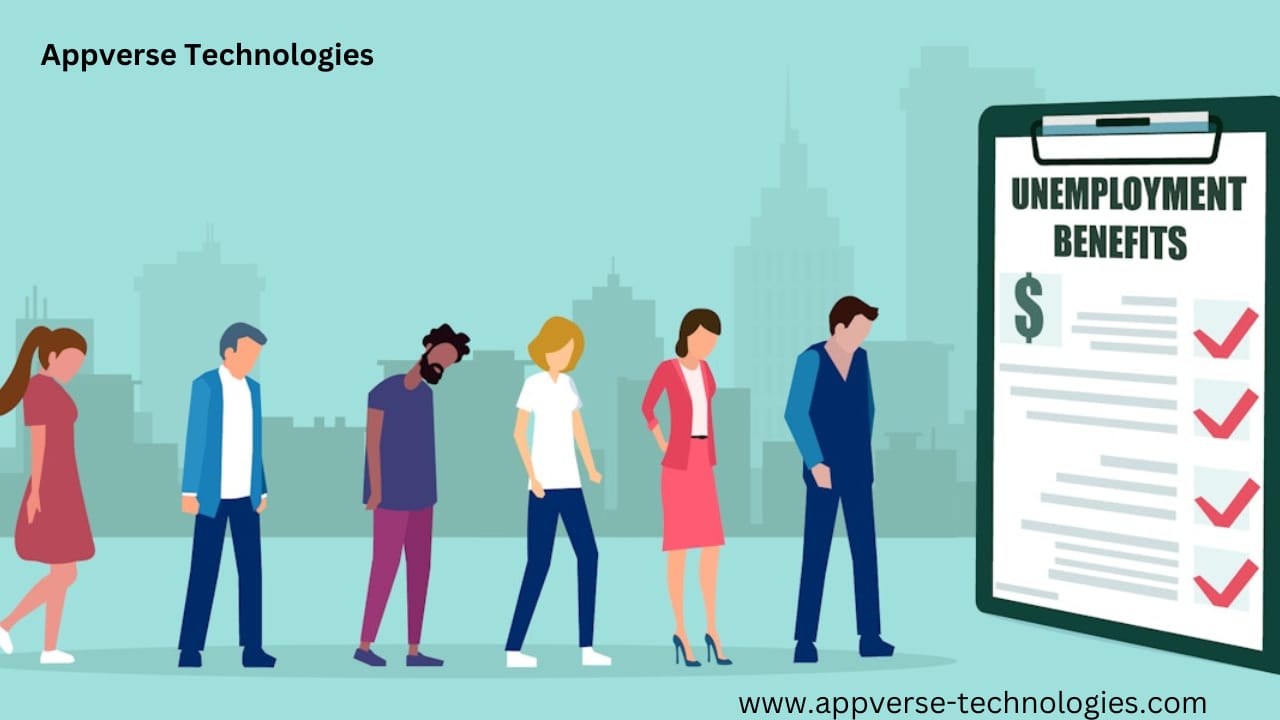
Unemployment is a term that describes individuals who are employable and seeking a job but are unable to find one:
Types of Unemployment:
- Demand Deficit Unemployment: This type of unemployment occurs during a recession when companies reduce their workforce due to decreased demand for their products or services.
- Frictional Unemployment: This type of unemployment occurs when workers are transitioning between jobs and is usually short-term.
- Structural Unemployment: This type of unemployment occurs when there is a mismatch between the skills of the worker and the available jobs.
- Voluntary Unemployment: This type of unemployment occurs when a worker decides to leave a job because it is no longer financially compelling.
Causes of Unemployment:
- Demand-side reductions: High interest rates, global recession, and financial crisis can contribute to unemployment.
- Supply-side reductions: Frictional and structural unemployment can contribute to unemployment.
Impact of Unemployment:
- Financial hardship: Unemployment can cause financial hardship for individuals and their families.
- Reduced consumer spending: Unemployment can lead to reduced consumer spending, which can negatively impact the economy.
- Long-term unemployment: Unemployment that lasts longer than 27 weeks can have even more severe effects.
Measuring Unemployment:
- Unemployment rate: The unemployment rate is calculated by dividing the number of unemployed people by the total number of people in the workforce.
- Surveys: Governments use surveys to track unemployment, such as the Current Population Survey (CPS) in the United States.
- Census counts: Governments use census counts to track unemployment.
- Unemployment insurance claims: Governments use unemployment insurance claims to track unemployment.
History of Unemployment:
- Great Depression: The highest rate of unemployment was during the Great Depression, when unemployment rose to 24.9% in 1933.
- Great Recession: Unemployment rose to 10% in 2009 during the Great Recession.
- COVID-19 pandemic: Unemployment hit 14.8% in April 2020 during the COVID-19 pandemic.
Solutions to Unemployment:
- Fiscal policy: Governments can use fiscal policy to influence the economy and reduce unemployment.
- Monetary policy: Central banks can use monetary policy to influence the availability and cost of money and reduce unemployment.
- Job training programs: Governments can implement job training programs to help workers acquire new skills and find employment.
- Unemployment insurance: Governments can provide unemployment insurance to help workers who have lost their jobs.
Unemployment is a complex and multifaceted issue that affects individuals, communities, and economies worldwide. It is a pressing concern that has far-reaching consequences on mental and physical health, family relationships, and social stability. In this essay, we will delve into the definition, types, causes, effects, and solutions to unemployment, as well as its historical context and current trends.
Definition:
Unemployment refers to the state of being without a paid job or occupation, despite being available and willing to work. It is a crucial indicator of a country’s economic performance and social well-being.
Types:
There are several types of unemployment, including:
- Frictional unemployment: temporary and short-term, occurring during job transitions.
- Structural unemployment: long-term, resulting from skill mismatches and industry changes.
- Cyclical unemployment: related to economic fluctuations and recessions.
- Seasonal unemployment: periodic, due to seasonal industries and weather conditions.
- Long-term unemployment: lasting over 27 weeks, with severe consequences.
Causes:
Unemployment is caused by a combination of factors, including:
- Economic downturns and recessions
- Technological advancements and automation
- Globalization and outsourcing
- Skills mismatch and education
- Demographic changes and population growth
- Government policies and regulations
Effects:
Unemployment has severe consequences on individuals, families, and communities, including:
- Financial hardship and poverty
- Mental health issues, such as depression and anxiety
- Physical health problems, like cardiovascular disease
- Family conflicts and relationship breakdowns
- Social isolation and community disintegration
- Loss of skills and human capital
Historical Context:
Unemployment has been a persistent issue throughout history, with notable peaks during the Great Depression (1929-1939) and the Great Recession (2007-2009). The COVID-19 pandemic has also led to significant job losses and unemployment globally.
Solutions:
To address unemployment, governments, businesses, and individuals can implement the following strategies:
- Education and training programs
- Job creation and infrastructure development
- Fiscal and monetary policies
- Labor market reforms and regulations
- Social safety nets and unemployment benefits
- Entrepreneurship and innovation support
Current Trends:
The job market is undergoing significant changes, with the rise of:
- Gig economy and temporary work
- Automation and artificial intelligence
- Remote work and digital nomadism
- Skills training and lifelong learning
- Diversity and inclusion initiatives
Conclusion:
Unemployment is a complex issue that requires a multifaceted approach to address its root causes and consequences. By understanding its definition, types, causes, effects, and solutions, we can work towards creating a more equitable and sustainable job market for all.
Unemployment is a complex issue with multiple factors contributing to its prevalence worldwide. Some key reasons include:
- Technological advancements: Automation and AI have replaced many jobs, especially in manufacturing and routine tasks.
- Globalization: Outsourcing and offshoring have led to job losses in some countries.
- Demographic changes: Aging populations and changes in workforce demographics have created labor market imbalances.
- Skills mismatch: Workers’ skills may not align with the needs of the modern job market.
- Economic fluctuations: Recessions, economic downturns, and financial crises have led to widespread job losses.
- Education and training: Insufficient access to quality education and training hinders workers’ ability to adapt to changing job markets.
- Labor market rigidities: Inflexible labor laws and regulations can limit job creation and hiring.
- Geopolitical tensions: Political instability, conflicts, and trade wars have disrupted global trade and investment, leading to unemployment.
- Environmental and climate change: Shifts in industries and economic activities due to environmental concerns have led to job losses in some sectors.
- Pandemics and health crises: The COVID-19 pandemic has highlighted the vulnerability of global labor markets to health crises.
Addressing unemployment requires a comprehensive approach that involves government policies, education and training programs, innovation, and social support systems.

The disadvantages of unemployment are numerous and far-reaching, affecting individuals, families, and societies as a whole. Some of the most significant disadvantages include:
- Financial hardship: Unemployment leads to a loss of income, making it difficult to meet basic needs and maintain a decent standard of living.
- Mental health issues: Unemployment can cause stress, anxiety, depression, and even suicide.
- Loss of skills and human capital: Prolonged unemployment can lead to skill erosion and a decline in human capital.
- Social isolation: Unemployment can lead to social exclusion, loneliness, and disconnection from community and social networks.
- Family conflicts: Unemployment can cause family tensions, relationship breakdowns, and even domestic violence.
- Poverty and inequality: Unemployment can perpetuate poverty and inequality, especially for marginalized groups.
- Reduced consumer spending: Unemployment leads to reduced consumer spending, which can negatively impact local businesses and the broader economy.
- Increased burden on social services: Unemployment can lead to increased demand for social services, such as healthcare, housing support, and food assistance.
- Decreased tax revenue: Unemployment reduces government tax revenue, making it harder to fund public services and infrastructure projects.
- Social unrest and political instability: High levels of unemployment can lead to social unrest, political instability, and even civil unrest.
- Loss of purpose and identity: Unemployment can lead to a loss of purpose and identity, particularly for those who define themselves by their work.
- Negative impact on physical health: Unemployment has been linked to poor physical health, including increased risk of cardiovascular disease and mortality.
- Reduced innovation and entrepreneurship: Unemployment can stifle innovation and entrepreneurship, as people may be less likely to take risks and start new businesses.
- Brain drain: Unemployment can lead to a brain drain, as skilled workers emigrate to other countries in search of better opportunities.
- Reduced economic growth: Unemployment can limit economic growth, as a significant portion of the workforce is not contributing to productivity and output.

Unemployment is a complex issue that requires a multifaceted approach to solve. Here are some solutions to address unemployment:
- Education and Training:
– Vocational training programs
– Skills development initiatives
– Education and certification programs - Job Creation:
– Infrastructure development projects
– Public works programs
– Encouraging entrepreneurship and small business growth - Labor Market Reforms:
– Flexibility in labor laws
– Encouraging part-time and temporary work
– Apprenticeships and internships - Social Safety Nets:
– Unemployment benefits
– Job seekers’ allowance
– Training and education support - Economic Growth:
– Fiscal policies to stimulate economic growth
– Monetary policies to control inflation and interest rates
– Encouraging foreign investment and trade - Innovation and Entrepreneurship:
– Encouraging start-ups and new businesses
– Supporting innovation and R&D
– Creating incubators and accelerators - Labor Market Information:
– Providing accurate labor market data
– Job market analysis and forecasting
– Career guidance and counseling - Active Labor Market Policies:
– Job placement services
– Career counseling and coaching
– Training and education programs - Addressing Structural Unemployment:
– Encouraging labor mobility
– Addressing skill mismatches
– Encouraging lifelong learning - Addressing Cyclical Unemployment:
– Fiscal policies to stimulate economic growth
– Monetary policies to control inflation and interest rates
– Encouraging consumer spending and demand
Some additional solutions include:
– Encouraging corporate social responsibility and job creation
– Supporting social entrepreneurship and impact investing
– Creating job opportunities in the green economy and sustainability sector
– Addressing discrimination and promoting diversity and inclusion in the workplace
It’s important to note that a combination of these solutions, tailored to the specific context and needs of a country or region, is likely to be more effective than any one solution alone.
To get rid of unemployment, a multi-faceted approach is necessary. Here are some steps that can be taken:
- Education and Training: Acquire new skills, upgrade existing ones, and invest in continuous learning to enhance employability.
- Job Search: Actively seek job opportunities, network, and utilize online resources like job portals and social media.
- Entrepreneurship: Consider starting a business or freelancing to create your own employment opportunities.
- Volunteer Work: Engage in volunteer work to gain experience, build networks, and develop skills.
- Internships and Apprenticeships: Pursue internships and apprenticeships to gain practical experience and make industry connections.
- Career Counseling: Seek guidance from career counselors or coaches to identify strengths and opportunities.
- Job Creation: Encourage governments and businesses to implement policies and initiatives that promote job creation.
- Economic Growth: Foster economic growth through innovation, investment, and trade to increase job opportunities.
- Labor Market Reforms: Implement labor market reforms that promote flexibility, reduce bureaucracy, and encourage hiring.
- Social Support: Provide social support and safety nets for the unemployed, such as unemployment benefits and training programs.
- Encourage Hiring: Incentivize businesses to hire by offering tax breaks, subsidies, or other benefits.
- Address Structural Issues: Address structural issues like skill mismatches, regional disparities, and discrimination to reduce unemployment.
Remember, overcoming unemployment requires a proactive and persistent approach.
Overcoming Unemployment: A Comprehensive Guide
Introduction:
Unemployment is a pressing issue that affects individuals, communities, and economies worldwide. It can lead to financial hardship, mental health issues, and social isolation. However, with the right strategies and support, it is possible to overcome unemployment and regain financial stability and personal fulfillment. In this essay, we will explore the steps to get rid of unemployment and regain a productive and meaningful life.
I. Education and Training
- Acquire new skills and upgrade existing ones
- Invest in continuous learning and professional development
- Pursue certifications and licenses to enhance employability
II. Job Search
- Actively seek job opportunities through online job boards, networking, and referrals
- Tailor resumes and cover letters to match job requirements
- Prepare for interviews and practice effective communication skills
III. Entrepreneurship
- Consider starting a business or freelancing to create own employment opportunities
- Develop a business plan and secure funding
- Build a strong network and marketing strategy
IV. Volunteer Work
- Engage in volunteer work to gain experience, build networks, and develop skills
- Showcase volunteer work on resumes and social media
V. Internships and Apprenticeships
- Pursue internships and apprenticeships to gain practical experience and make industry connections
- Build a strong portfolio and reference list
VI. Career Counseling
- Seek guidance from career counselors or coaches to identify strengths and opportunities
- Develop a personalized career plan and job search strategy
VII. Job Creation
- Encourage governments and businesses to implement policies and initiatives that promote job creation
- Support local businesses and entrepreneurs
VIII. Economic Growth
- Foster economic growth through innovation, investment, and trade
- Encourage entrepreneurship and job creation
IX. Labor Market Reforms
- Implement labor market reforms that promote flexibility, reduce bureaucracy, and encourage hiring
- Encourage apprenticeships and on-the-job training
X. Social Support
- Provide social support and safety nets for the unemployed, such as unemployment benefits and training programs
- Encourage community engagement and social connections
XI. Encourage Hiring
- Incentivize businesses to hire by offering tax breaks, subsidies, or other benefits
- Encourage diversity and inclusion in hiring practices
XII. Address Structural Issues
- Address structural issues like skill mismatches, regional disparities, and discrimination
- Encourage lifelong learning and upskilling
Conclusion:
Overcoming unemployment requires a proactive and persistent approach. By acquiring new skills, actively seeking job opportunities, and considering entrepreneurship, individuals can regain financial stability and personal fulfillment. Additionally, addressing structural issues, promoting job creation, and providing social support can help reduce unemployment rates and create a more productive and inclusive society.

Unemployment Solutions: Empowering Individuals and Communities
Introduction:
Unemployment is a pressing issue that affects individuals, families, and communities worldwide. It can lead to financial hardship, mental health issues, and social isolation. However, with the right solutions, it is possible to overcome unemployment and regain financial stability and personal fulfillment. In this blog, we will explore effective unemployment solutions that empower individuals and communities.
Solution 1: Education and Training
- Acquire new skills and upgrade existing ones
- Invest in continuous learning and professional development
- Pursue certifications and licenses to enhance employability
Solution 2: Job Search Strategies
- Actively seek job opportunities through online job boards, networking, and referrals
- Tailor resumes and cover letters to match job requirements
- Prepare for interviews and practice effective communication skills
Solution 3: Entrepreneurship and Innovation
- Consider starting a business or freelancing to create own employment opportunities
- Develop a business plan and secure funding
- Build a strong network and marketing strategy
Solution 4: Community Support and Resources
- Access local job fairs, career counseling, and training programs
- Utilize online resources and job search platforms
- Join support groups and networking events
Solution 5: Economic Development and Job Creation
- Encourage governments and businesses to implement policies and initiatives that promote job creation
- Support local businesses and entrepreneurs
- Foster economic growth through innovation, investment, and trade
Conclusion:
Unemployment requires a comprehensive approach that addresses individual skills, job search strategies, entrepreneurship, community support, and economic development. By empowering individuals and communities with the right solutions, we can overcome unemployment and build a more prosperous and inclusive society.
The rate of unemployment varies significantly across the world, depending on the country, region, and economic conditions. Here are some approximate unemployment rates for different regions and countries:
1. Global unemployment rate: 5.2% (2022 est.)
2. Advanced economies:
– United States: 3.6% (2022)
– European Union: 6.3% (2022)
– Japan: 2.4% (2022)
3. Emerging markets and developing economies:
– China: 3.9% (2022)
– India: 7.1% (2022)
– Brazil: 12.2% (2022)
4. Africa:
– South Africa: 34.4% (2022)
– Nigeria: 33.3% (2022)
– Egypt: 12.3% (2022)
5. Asia-Pacific:
– Australia: 5.1% (2022)
– South Korea: 3.7% (2022)
– Indonesia: 5.3% (2022)
6. Latin America and Caribbean:
– Mexico: 3.5% (2022)
– Argentina: 10.6% (2022)
– Colombia: 12.2% (2022)
Note: These rates are subject to change and may vary depending on the source and methodology used.
Sources:
– International Labour Organization (ILO)
– World Bank
– National statistical offices
– International Monetary Fund (IMF)
Keep in mind that unemployment rates can fluctuate over time due to various economic and social factors.


Alizay Ali is a skilled HR manager with two years of experience at AppVerse Technologies. With her strong interpersonal skills and expertise in talent acquisition, employee engagement, and HR operations, she plays a pivotal role in fostering a positive and productive work environment. She with a passion for learning and a drive to succeed, she eagerly embraces new challenges and is poised to make her mark in the ever-evolving world of technology
